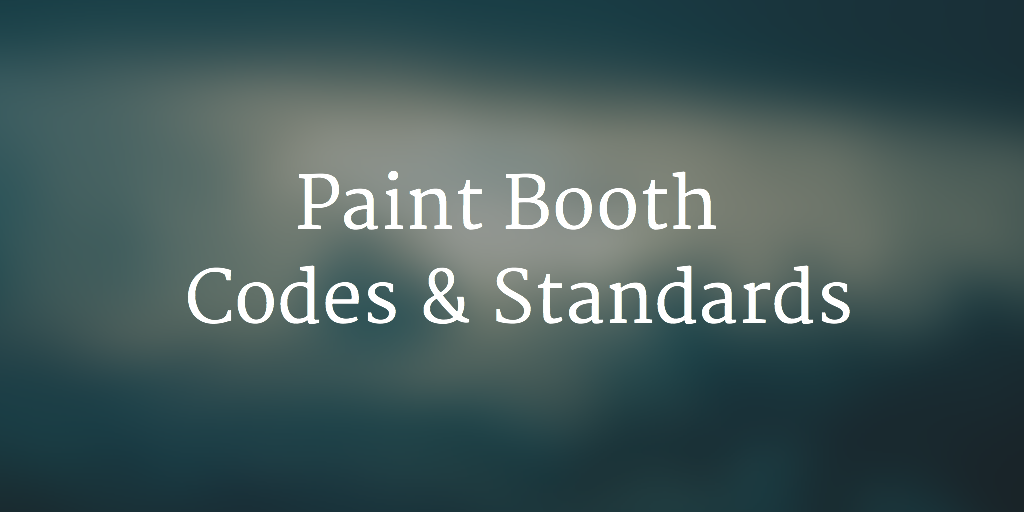In general, the first rule in bodywork is safety first. Dealing with heavy weight automotive machines and equipment can create a hazardous work environment if you are not careful. That includes using flammable materials and liquids like those that are used in paint booth products.
We have put together a list of some of the main paint booth codes and standards that you should know. This list applies to most body shops that use paint booths and some localities impose even stricter guidelines and regulations. You can learn more about spray booth safety and regulatory codes set forth by the NFPA (National Fire Protection Association), EPA (Environmental Protection Agency), and OSHA (Occupational Safety and Health Administration) online.

Fire Safety and Prevention Codes for Paint Booths
Among the many rules governing spray painting businesses, the mixing room is one of the most widely observed fire and prevention requirements. Because spray paint, solvents, lacquers, and thinners are considered hazardous materials due to their flammability, many businesses operating spray booths are required to have a mixing room on the premises.
We sell mixing rooms in addition to our paint booth products that meet all federal standards and many local and state regulations. Safety codes for proper ventilation while using these materials as well as storage and placement of flammable products and mixing rooms are defined by EPA, NFPA, and OSHA.
Other fire safety and prevention rules include codes that set standards for the construction and manufacturing of spray booths, specifications on designated spray areas, and standards for how many spray rooms and mixing rooms are required. These rules vary from state to state and even locally that detail standards for:
- Proper Ventilation
- Sprinklers and Fire Extinguishers
- Area Maintenance
- Paint Drying or Curing
- Electrical Design and Use
- General Building Operations
These rules are often updated and changes are added to reflect new regulations. In addition to the rules set by the NFPA, the IFC (International Fire Code) contains information regarding building construction and safety codes related to spray painting operations.
Worker Safety Codes for Paint Booths
Government standards that dictate the proper work environment for spray paint operators not only help to prevent costly workplace injuries and accidents but save thousands over the long run. Because workers using our paint booth products run the risk of exposure to harmful chemicals, all of our Accudraft paint booths are made to meet or exceed regulatory standards.
There are two main areas of worker safety codes that guide the construction of our products; contamination and fire injuries. Paint products are flammable and while the fire codes help to establish a safer work environment, employees must also be made aware of safety standards.
OSHA typically requires training, certification, and inspection for employees and worksites. Some of the things that these standards verify are:
- The manner in which chemical operators perform their job duties
- The layout and design of spray painting equipment
- The location and manner in which flammable products are stored
- And the precautions used to prevent inhalation of toxic pollutants and contaminants
Some of the materials used in a spray painting facility are also regulated by the Federal Clean Air Act. These codes apply to usage as well as disposal of hazardous waste and materials.
Energy Efficiency Rules for Paint Booths
Many of the energy efficiency rules and standards being applied across the country are new to the spray painting industry. These more than any other of the codes and standards are typically more localized and enforced by state and local agents, though there are some federal regulations being crafted and may soon be enacted.
For the most part, energy efficiency rules are a win-win for business operators. While these rules are made to reduce pollution, they are also designed to save on energy use thereby reducing energy costs. Federal energy efficiency rules are generally enforced by the EPA and include:
- Spray Paint Emissions
- Waste Reduction
- Power Usage
- Drying Systems and Paints
At Accudraft, we are also leading the way in green technology for spray painting operators. We sell waterborne drying systems to help companies switching from solvent based paints to waterborne paints and we also are saving businesses money on energy costs with our new Accudraft EnergySmart VFD Drive.
As a business owner of a body shop that uses spray painting technology, it is imperative that you stay abreast of the latest codes and standards. Particularly for green alternatives, the rules are constantly changing and can help you save money while saving the environment.